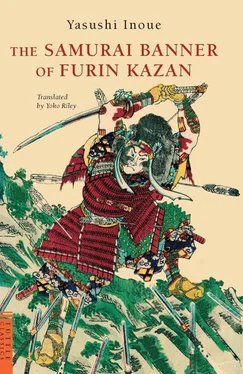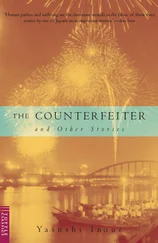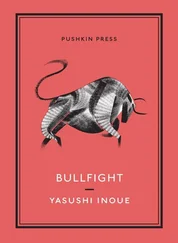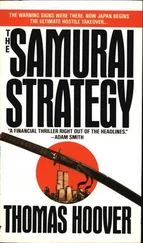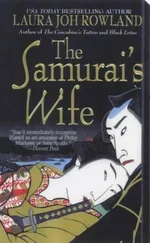In this situation, it was absolutely necessary for the Takeda to gather their forces at the border of Shinano and Echigo and point their dagger to the heart of Echigo.
As soon as they arrived at Kaizu Castle, Shingen defined the stations for each of his generals and prepared for his advance on Echigo. The army had to be ready at a moment’s notice. Shingen also sent a small troop of warriors to support the Hojo family. 92
He could not afford to send a large battalion, since he could only afford to place a small number of warriors in defense of Kofuchu.
The power of the Takeda was assembled in the land of northern Shinano.
In March, Kenshin surrounded Odawara Castle with the 96,000 warriors assembled by his allied generals in Kanto and Oou district. Once the Hojo’s Odawara Castle fell, without a moment’s delay, Shingen was planning on advancing on Echigo.
Throughout his forty-one years of life, this was the most eventful and uncertain time that he had ever experienced.
Kansuke kept silent during this time of preparation. He was just hoping that Odawara Castle would not fall. If it fell, whether they liked it or not, the Takeda army had to force a raid on Echigo, attacking in Kenshin’s absence. In return, Kenshin would stampede to Kai. After that, how the state of this war would change was beyond prediction. It would no longer be strategy nor the skills of war that would result in victory. It would all depend on luck. Shingen’s talent or bravery was no longer useful.
He required neither Kansuke nor Kosaka.
Kansuke did not want to let Shingen fight with Kenshin in such a state of war. On March the thirteenth, Kenshin deployed a full-scale offensive at Odawara Castle. However, the castle was known for its unassailability, and besides, the warriors defended their castle in desperation with a mighty force — it would not fall that easily. Finally Kenshin gave up on this venture, and at the end of the same month he withdrew from his siege of the castle and returned his army to Echigo.
It was apparent that Kenshin, who had abandoned his assault on Odawara Castle partway through, might attempt to commence battle with the Takeda army again simply to save face.
At the end of June, as soon as he returned to Kasugayama Castle where he resided, he rested his cavalry.
Kansuke suspected that it would be mid-autumn when Kenshin would advance with his army to northern Shinano. The Echigo troops, which had spent eleven months on their campaign in the Kanto district, required at least that much rest. But they would not wait till the next year, Kansuke thought. It was natural for Kenshin to wish to regain his honor as soon as possible. The shame brought on by his defeat at Odawara Castle was still fresh in everyone’s mind.
On the night of August the fourteenth the general of Kaizu Castle, Kosaka Masanobu, received information of Kenshin’s advance into northern Shinano. It was said that Kenshin was advancing with approximately 13,000 warriors. Having passed Tomikura Sunset Point, he had entered Obu, 93heading in the direction of Kawanakajima.
Up on Noroshi 94Mountain behind Kaizu Castle, a signal flare was sent up. A pillar of fire rocketed to the center of the sky and sparks of fire burned through the darkness of the night.
Signals were sent up one by one from one mountain to the next. This had been the prearranged method for sending information to the south. These were the Gorigatake, 95Summit of Two Trees, Koshigoe, Nagakubo, and Wada Sunset Point. Pillars of fire were relayed from one mountain to another and shot up on the summit. Acting in unison with the signal, a group of post-horses dashed out in the darkness, with two or three warriors per group, from Kaizu Castle.
On the night of the fifteenth, Shingen learned the news from a fire signal sent up from one of the mountains. On the day of the sixteenth, he learned how many warriors their enemy consisted of, this through the express messengers. When the messenger arrived, the castle boundary of Kofuchu was already filled with samurai who were ready to leave for battle.
From then on, for three days, warriors left the castle town, divided into numerous groups and preparing their battle formations. It was the eighteenth of August when the last of the main army, led by Shingen, left Kofuchu.
Kansuke joined the very first group of the huge army as it marched out of Kofuchu. Close to twenty years had passed since he had first stepped here in the twelfth year of Tenbun. Kansuke thought that this would be the last time he left his footsteps on this great land.
He foresaw the end of his long life. He could not predict which side would win, but he never thought that the Takeda would lose, as Kosaka Masanobu had predicted. This victory had to be placed on Shingen’s shoulders. They had to win by any means possible.
However, for some reason, Kansuke felt that he would never set foot on the soil of Kofuchu again. If I do not die in this battle, I will never die in any other battle, he thought. He felt that he might live for a long time to come, if death did not come soon. But, he wanted to control his own destiny. Every human being has his own right time to die. The right time for him to die seemed to be in this battle.
Kansuke headed toward Takashima Castle in Suwa with his five retainers, leaving his troops, which were heading towards northern Shinano. Since Shingen’s main army would not be leaving Kofuchu for two days, Kansuke thought of doing two things in those two days. One was to visit the grave of Princess Yuu, which was on the hill of the Kan-non-in Temple, and the other was to pick up Katsuyori. This was, of course, not only Kansuke’s plan, but also Shingen’s. He had agreed to select this war as Katsuyori’s first campaign.
When he entered Suwa, Kansuke met many troops who were leaving to join the main army from Kofuchu. From the general who was leading the first troop, Kansuke learned that Katsuyori had been in the Ina district, not in Suwa, for the past six months.
The representative of Ina was Akiyama Nobutomo, and he was in charge of protecting the castle in Takato. Therefore, Katsuyori had most likely heard the urgent news at Takato Castle and like-wise, he must have left there along with Akiyama Haruchika.
Kansuke thought that Akiyama’s army should pass this same road either that day or the next, so Kansuke could welcome him right there. Kansuke wanted to support Katsuyori’s first campaign on his own. He wanted to march onto the battlefield beside him.
Kansuke turned his horse to Takashima Castle. Although he had entered the castle town, he did not go into the castle.
Knowing that Katsuyori was no longer here, there was no use of going into the castle where the warriors would be in preparation for departure. Kansuke passed the front gate and continued along the shore of Lake Suwa. The six horses, led by Kansuke, galloped against the wind, all riders with their bodies bent in half.
The sun was just about ready to set, and its last glow was reflecting in rust-red tones over the lake.
Kansuke occasionally rested his horse. He felt excruciating pain when his horse galloped the whole way up. He could not overcome his age. When he rested his horse, he felt the cold wind on his cheeks. It was the cold autumn wind, come to chill his aching bones.
Princess Yuu’s tomb was located halfway up the hill to the Kan-non-in Temple, where she had lived for a long time and died peacefully. Five years had passed rapidly since she had left this world.
Leaving his retainers outside, Kansuke went to the graveyard alone. He knelt down as if Princess Yuu was sitting in front of him.
“Princess,” he called out loud, “Princess, it has been a long time. I am sorry for not visiting you more often, but I have been so busy with all the battles. You must have been awfully lonely.
Читать дальше
